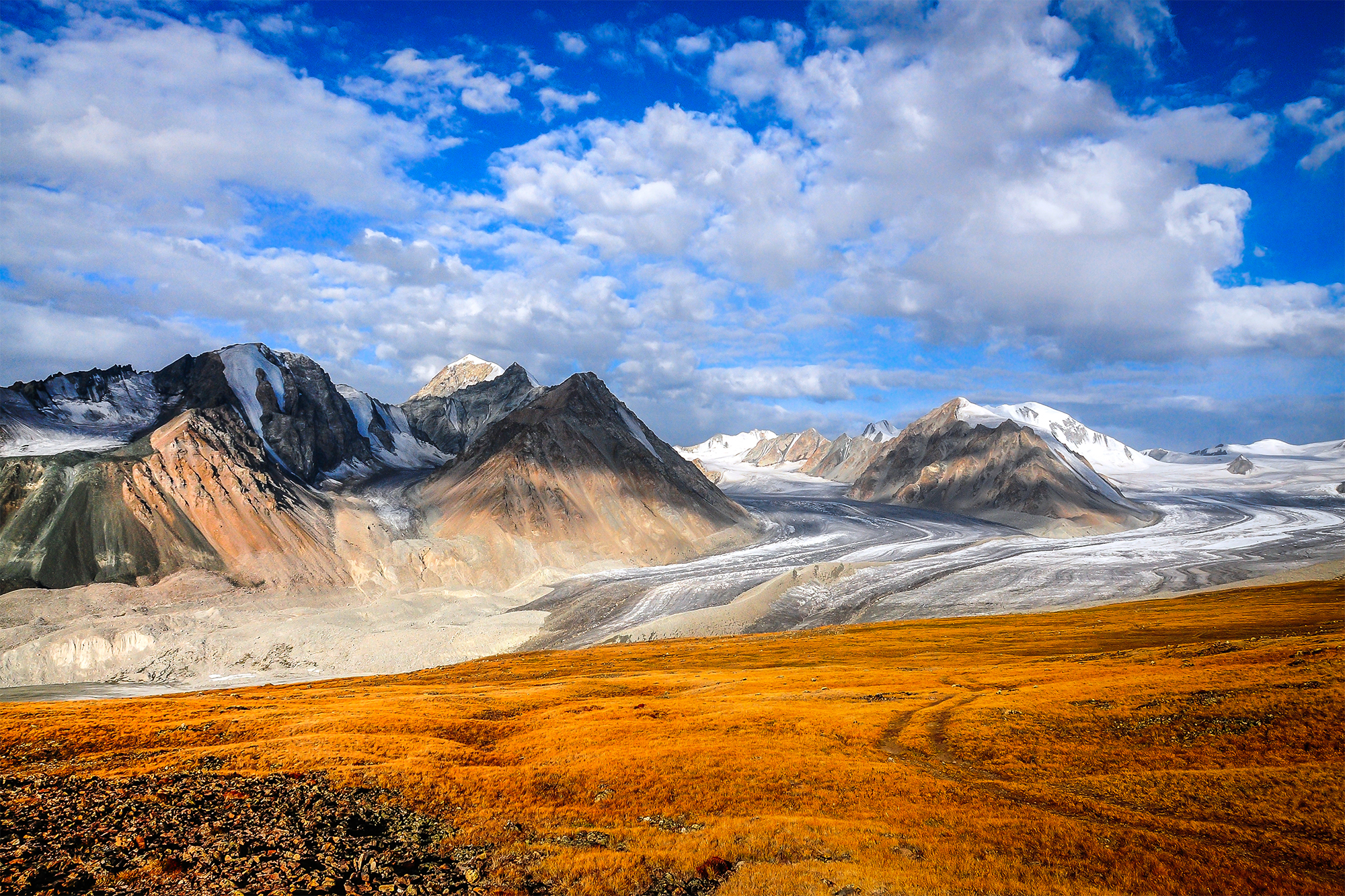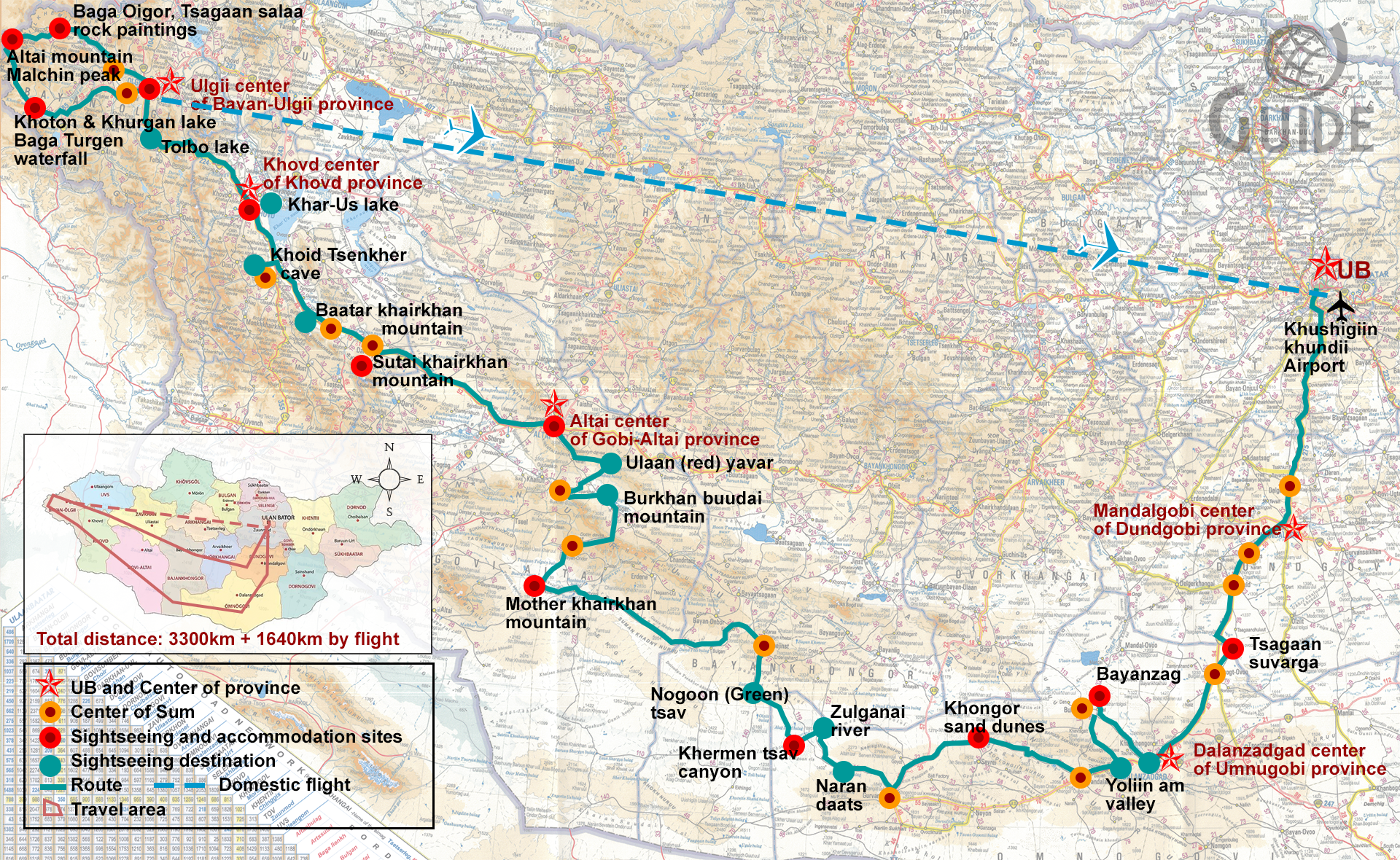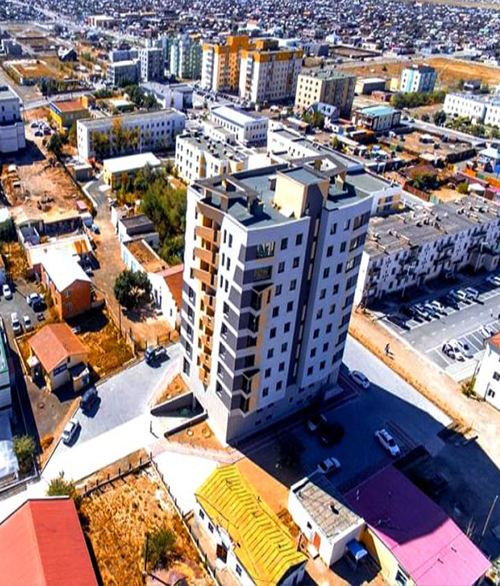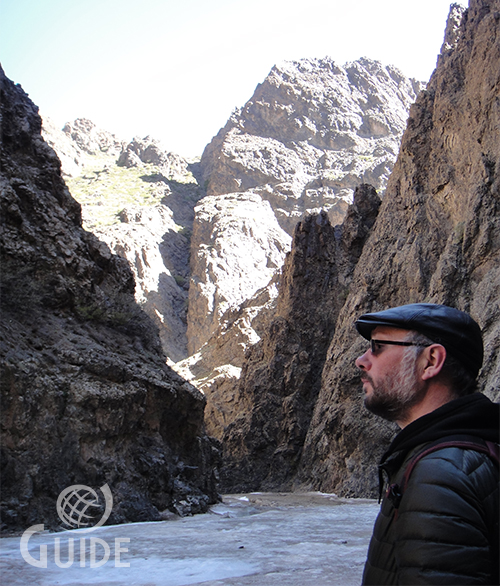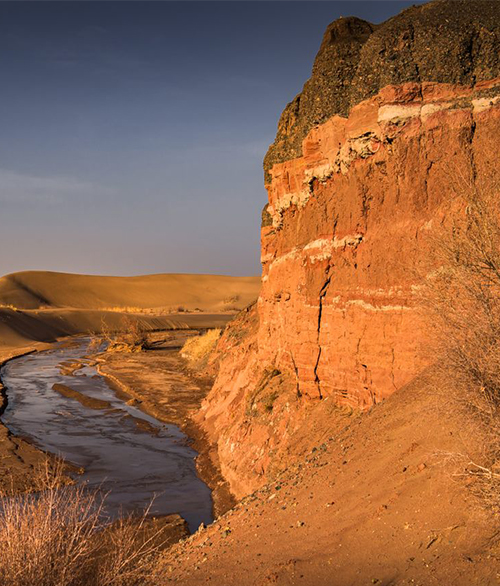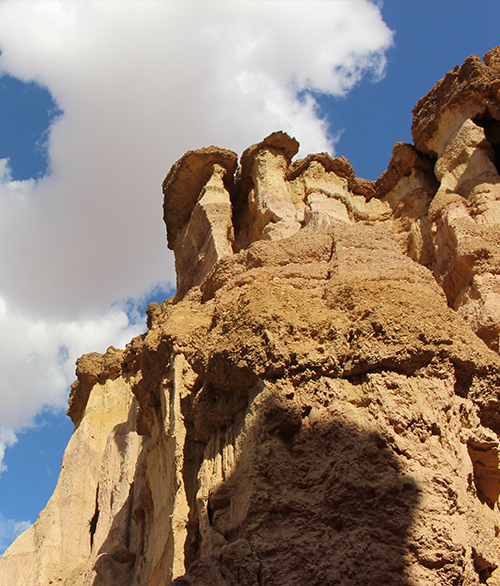Itinerary
DAY 1: Chinggis Khaan Airport – UB (55 km)
Arrival at Chinggis Khaan International Airport at Khushig Valley. (The city tour will be planned depending on your time of arrival at the airport)
Meal: Dinner
Accommodation: Hotel
DAY 2: UB – Mandalgovi – Tsagaan Suvarga (450 km)
Early morning, departing from Ulaanbaatar, drive to the Tsagaan Suvarga which is unique formation located in the Gobi Desert. Once was the ocean bed where the visitors find marine fossils and clamshells, the Tsagaan Suvarga is 30m-60m high and 6000m long colorful limestone formations. We will drive from Ulaanbaatar on 420 km on paved road and 30 km on unpaved road. The travelers take lunch at Dundgovi province’s center. The Tsagaan Suvarga has unusual formations and is a beautiful spot both day and night, especially during the sunset and sunrise we will experience of extraordinary natural scenery.
Meal: Breakfast, Lunch, Dinner
Accommodation: Tourist camp
DAY 3: Dalanzadgad – Bayanzag (250 km)
After departure from the Tsagaan Suvarga, upon arrival at Dalanzadgad city, Umnugovi province’s center, the travelers visit the Natural History Museum and take lunch at Dalanzadgad. Then we drive to the Bayanzag. The Bayanzag red sand cliffs is the place where the 20th century American famous paleontologist Roy Chapman Andrews expedition was the first to discover dinosaurs’ bones and eggs in the 1920s. Today well known as “flaming cliffs” due to its colors ochre and red, Bayanzag’s discovery has drawn the whole world’s attention to the Mongolian Gobi and it is marked as “Gobi” in the history of the world paleontological science. In the Bayanzag, not only important fossil finds have been made but also a large landmark inhabited by ancient people was discovered.
Meal: Breakfast, Lunch, Dinner
Accommodation: Tourist camp
DAY 4: Yoliin am (valley - Khongor sand dunes (230 km)
After breakfast, take a walk through the Yoliin am (Eagle valley or bearded vulture valley). It is a high rocky gorge about 2800 meters above sea level and named after Yol bird (bearded vulture). Through the corridor of rock walls, it has a small stream. Also, between the rock walls, there occurs a thick corridor of ice where the sun never shines and that stretches along a considerable distance. Some places have 200-meter-high straight rock walls which have breathtaking scenery.
After taking lunch in the Yoliin am, we drive to Khongor sand dunes. The Khongor sand dunes is one of the major tourist destinations in Mongolia. This dune is considered one of the biggest and most spectacular dunes with the length of 180 km running from the northwest to the southeast. The widest part of the sand is 27 km in the northwestern part, and the narrowest is 800 meters in the central part. There are rocky mountains in front of the Khongor sand dunes, and a green oasis with a small river in the north. These seemingly endless sand dunes and their shining golden yellow color on a windless sunny day are a wonderful natural spectacle. Here, the travelers ride a camel through Duut mankhan (Voicy mankhan which generates sound similar to that of airplanes) and see the sunset.
Meal: Breakfast, Lunch, Dinner
Accommodation: Tourist camp
DAY 5: Naran daats – Zulzganai river – Khermen tsav (290 km)
From the Khongor sand dunes, crossing through the West and east saxual tree forest and sand dunes, arrive at the “Cradle of Bataar” tourist camp in Naran daats and take lunch. The Naran daats is one of the main sources of fresh drinking water in the desert. Around the Naran daats, dinosaur fossils are still found these days. Continuing the tour, travelers cross the Zulganain River, a wonderful oasis in the depths of the desert, and arrive in the Khermen Tsav. The Khermen tsav is called as Mongolian Grand Canyon and is the largest mud wall formation in Mongolia, where the world's rare Peacock tree grows. Sunrise and sunset in Khermen tsav is truly beautiful, as well as it is a wonderful spot for a photoshoot.
Meal: Breakfast, Lunch, Dinner
Accommodation: Tent
DAY 6: Nogoon tsav (Green tsav) – Shinejinst (280 km)
After having breakfast during sunrise, depart to the Green tsav. Located in Bayankhongor province, which is a neighboring province on the west side of Umnugovi province, the Green tsav is a place of unique natural sightseeing with strange formations. The sandstones and sediments of Green tsav’s both sides have been eroded by the force of water and wind over time and they look like the beaks and heads of some giant animals. After seeing the Green tsav, we arrive at Shinejinst soum and take lunch there. After lunch, we depart to Eej Khairkhan Uul (Mother Mountain). Depending on the way, will choose the convenient place to accommodate.
Meal: Breakfast, Lunch, Dinner
Accommodation: Tent
DAY 7: Eej khairkhan (Mother khairkhan mountain) -160 km
We arrive and camp at the base of Mother Khairkhan mountain which is another miracle of the Gobi Desert. It is a single granite stone mountain abruptly rising on the sand and gravel plains between Mongol Altai and Gobi Altai Mountains. On the eastern slope of Eej Khairkhan Mountain are nine pools called “Nine pots” and it is the top attraction of the mountain. Every pot has water within itself and easily accessible to one another by a stone threshold. The first 3 pots’ diameter is 1m –3m and 4th to 8th pots’ diameter is about 5m-6m. On this day, there we will stay overnight camping in a tent.
Meal: Breakfast, Lunch, Dinner
Accommodation: Tent
DAY 8: Ulaan Yavar (Red canyon) – Altai city (280 km)
Early morning, we drive to the amazing red sandstone of Ulaan Yavar (Red Canyon) lies right in the northern foothills of Burkhan Buudai Mountain, located in Gobi-Altai Province. Anyone who sees the Red Yavar once was an ocean floor millions of years ago (Red canyon) feels as if they have been to another planet. On a clear sunny day, it shows extraordinary beauty. Departing from the Red Yavar, we will arrive in Altai city of Gobi-Altai province, which is the most southwestern region of Mongolia, and take a rest in a hotel. After camping for 3 days in a tent and driving through an unpaved road, our travelers need to take a good rest.
Meal: Breakfast, Lunch, Dinner
Accommodation: Hotel
DAY 9: The Sutai Khairkhan mountain (220 km)
The Sutai Khairkhan mountain is one of the major mountains which have been worshipped by the people of Govi-Altai and Khovd provinces. Its peak has permanent snow and is one of the 10 Mongolian peaks above 4000 meters above sea level. We will spend the night at the tourist camp at the northern foot of the Sutai Khairkhan, which stretches for 60 km. In 2008, by the decree of the Mongolian President, this beautiful place with a black forest behind it was made a state shrine. Now every 5 years, Great Peak (Ikh Ovoo) is worshipped by the people. Many rivers flow from the snow-covered peak of the Sutai Khairkhan mountain. Most of the road to the Sutai Khairkhan mountain is paved.
Meal: Breakfast, Lunch, Dinner
Accommodation: Tourist camp
DAY 10: Baatar khairkhan mountain (Hero khairkhan) – Mankhan soum – Khovd city 250km
After breakfast, we depart for Khovd city. Through the way, we take lunch at the foot of the ever-snowy Baatar khairkhan mountain. Next, we will visit the Khoit Tsenkher Cave (Khoid Tsenkheryn Agui) which has Paleolithic period cave paintings. The Cave is located about 30 km from center of the Mankhan soum, about 80 km from the center of Khovd province, Mongolia. Scientists believe that age of drawings of the Cave is approximately 40000 years old. The cave contains many figures and most of the major images have been painted onto the walls using mineral pigments (red and yellow ochre, hematite, manganese oxide and charcoal), although some designs have also been incised into the stone. Done with light pink and red-brown ochre pigments, the paintings depict Paleolithic fauna such as mammoths and ostriches which are no longer found in the area of Mongolia. Unfortunately, many of the drawings have now been defaced nowadays or covered with dust and are no longer visible. We drive 200km through the paved road.
Meal: Breakfast, Lunch, Dinner
Accommodation: Local hotel
DAY 11: Khovd city - Ulgii city (150 km)
On this day, travelers visit the Multi-Ethnic Culture Museum in the center of Khovd city and take a tour through the streets with the remains of walls related to the Manchurian rule period. While taking lunch the travelers enjoy the music and dance of ethnic groups of Khovd province and visit the shopping center of Hovd city. Khovd province is known as the land of fruits (grows watermelon). Then, we move further and arrive in Ulgii city, the most western city of the Mongolia. A minority of the Mongolian population, Kazakhs live here. We will get to know the uniqueness of Ulgii city and visit the Islamic Mosque.
Meals: Breakfast, lunch, dinner
Accommodation: Hotel
DAY 12: Baga Oigor Tsagaan Salaa rock paintings – Ekhi Ashe (150 km)
Departing from the Ulgii city, the tour will lead us through the area of Ulaankhus soum, passing the Siilkham mountain range, crossing the Chalpakh mountain pass, and from the pass, we can see the top of the Altai Tavan bogd Mountains. On the way, travelers will see the lower Tsagaan Salaa and upper Baga Oigo rock paintings. Through the way, we will pass by graves, ancient human statues, camps of Kazakh families, eagle hunter families, Khokh Ereg outposts and border military posts. Since its first discovery in 1979, the joint Mongolian/American/Russian project "Altay" which began in 1994 determined the lower Tsagaan Salaa and upper Baga Oigor as one of the largest rock art complexes in North and Central Asia, and the richest in terms of chronological age, quantity, and quality of imagery.
With a width of 500m and length of 15000m, there are more than 10,000 images of various animal species, hunting scenes, and scenes depicting aspects of human life in the region from new Stone Age to the Bronze age. The main theme of the rock paintings is animal husbandry and hunting, and in addition to one or two animals, there are also large herds with over a hundred. The results of the research were published in Paris in 1999 and this place became well-known in the field of archeology in the world.
Meals: Breakfast, lunch, dinner
Overnight: Tent
DAY 13: Malchin camp by Horse riding (20 km)
On this day, we will ride the horses (hired horses), and load the camel and cross the river towards Malchin Peak directed up through the Potanin Glacier. Malchin peak is the nearest peak of the Altai Tavan Bogd mountain. The Altai Tavan Bogd Mountain is located on the western frontier of Mongolia and borders with China and Russia. It stretches from northwest to southeast of the Mongolian border. There are many tombs in the Altai Tavan Bogd Mountain national park, dating back to the ancient Hunnu, Turkic, Uyghur, and Mongolian empires, some of their dates have not been precisely determined yet. Petroglyphs, lapidary inscription of symbols and characters which dates back to 2500 to 3000 years are common here.
Altai mountains consist of black, brown, and marshy soil as well as rocky terrain and it is the greatest attraction in the west of the country. Named after the Russian explorer Grigory Potanin, the longest glacier in Mongolia, the Potanin glacier continues over 20 kilometers in length and 5km in width starting from the Tsagaan river. Once we reach the destination, we choose the convenient campsite to stay overnight.
Meals: Breakfast, lunch, dinner
Overnight: Tent
DAY 14: Malchin camp – Tsagaan river valley – Khoton lake (60 km)
Following down the Potanin Glacier, we arrive at the White River Valley. The car will be waiting for us here. We will travel through the Shiveet mountain base and visit the Uriankhai herder family. Take overnight camping at the shore of the Khoton freshwater lake. In the vicinity of the Khoton Lake, there are grave shrines with two stone figures and a very interesting shape. The Baga Turgeny Waterfall is one of the several waterfalls on the west coast of Khoton and Khurgan Lakes between the Turgeny Mountains. When descending from a steep cliff with a total height of 36 meters, it forms two waterfalls, a big and a small one with a cascade pattern.
Meals: Breakfast, lunch, dinner
Overnight: Tent
DAY 15: Khoton Lake – Ulgii city (100 km)
We will drive to the Ulgii city early morning. In the Ulgii city, travelers visit the museums and stay in a hotel, take a well rest after long tour.
Meals: Breakfast, lunch, dinner
Accommodation: Hotel
DAY 16: Ulaanbaatar (1640 km by flight + 55 km drive)
The travelers depart from the Ulgii city by domestic flight and arrive in Ulaanbaatar. Take a rest at the hotel. While the tour car will drive from the Ulgii city to Ulaanbaatar over 3 days.
Meals: Breakfast, lunch, dinner
Accommodation: Hotel
DAY 17: UB - City tour
Travelers will take a city tour and visit Museums and Sukhbaatar Square, the hub of Ulaanbaatar, do shopping in the souvenir shops and markets. Take time to prepare for the home return trip.
Meal: Breakfast, Lunch, Dinner
Accommodation: Hotel
DAY 18: Chinggis Khaan Airport (55 km)
Take a return flight to the respective country from the Chinggis Khaan International Airport.
Meal: Breakfast


